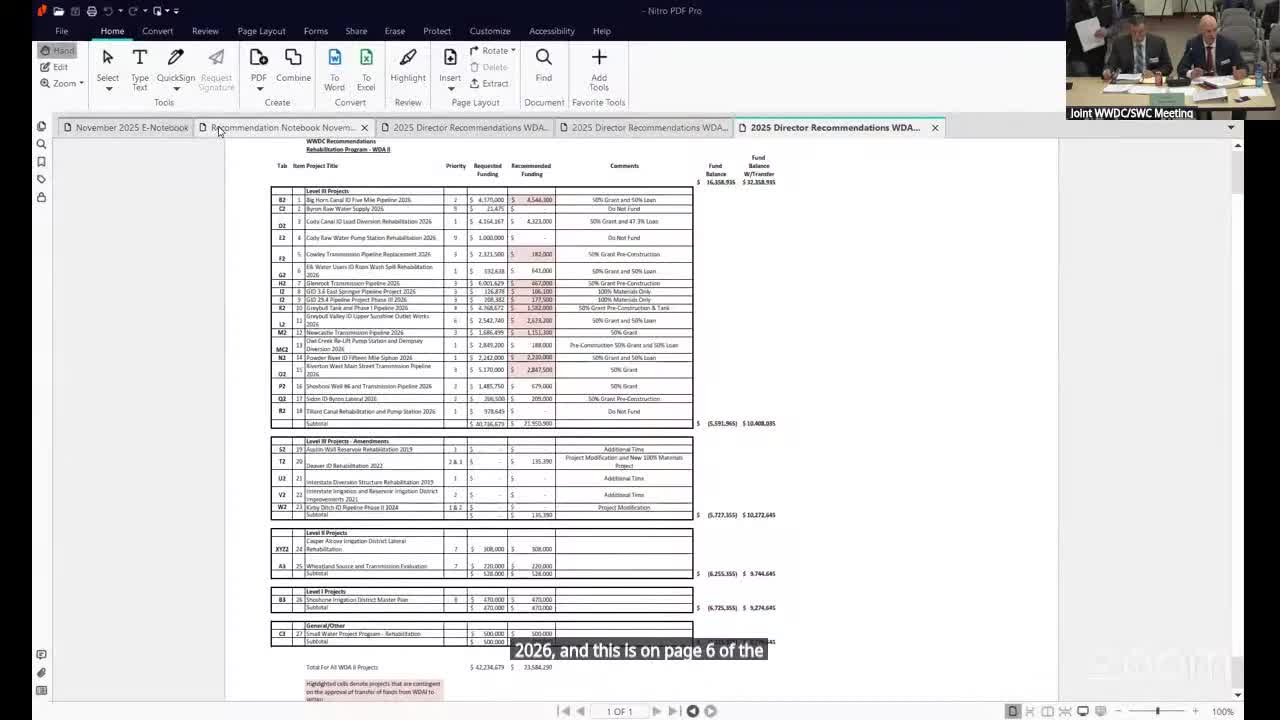Little Snake districts buy Battle Lake parcel, secure $1.09M from WWDC for forest‑management demonstration and modest lake modification
November 05, 2025 | Agriculture, State & Public Lands & Water Resources Committee, Senate, Committees, Legislative, Wyoming
This article was created by AI summarizing key points discussed. AI makes mistakes, so for full details and context, please refer to the video of the full meeting. Please report any errors so we can fix them. Report an error »

The Wyoming Water Development Commission approved a $1,092,000 funding package at the Oct. 28 meeting to support forest‑management activities and a small outlet modification at Battle Lake, a 20‑plus acre glacial lake in the Little Snake River headwaters. The Little Snake Conservation District and Savory Little Snake River Water Conservancy District had earlier sought a larger package that included 50% of an anticipated land purchase; sponsors withdrew the purchase request after the conservation district acquired the property.
Senator Dan Hicks and local district representatives described the project as a demonstration to increase water yield from headwater forested landscapes. Jack Cobb, chairman of the conservation district, said the parcel’s purchase preserves family ranching and creates an opportunity to manage the headwaters for multiple benefits, including increased water yield for the Colorado River Basin, native cutthroat restoration potential and recreation. Assistant State Forester Matt Marshall and other technical staff explained that a body of published and federal research supports the premise that targeted vegetation management (reducing basal area by specified percentages in key watersheds) can increase net water yield; they noted the U.S. Forest Service has previously constrained similar federal actions to avoid unintended impacts.
Sponsors requested 50% of estimated implementation costs and $170,000 for a Battle Lake outlet modification. Director Mead’s review found program eligibility questions and noted the office’s usual practice requires planning studies before funding construction and raised concerns about program budget pressure if many such projects are pursued. Following extended discussion among commissioners and staff about eligibility, scientific measurement, and statewide program priorities, the commission voted to provide $1,092,000 to fund forest treatments and construct a limited Battle Lake outlet modification. The $1.092M figure reflects the sponsors’ revised ask after withdrawing the purchase request; it does not include the earlier $1.5M land purchase request.
Commissioners stipulated that the project should use scientific monitoring methods (proposals discussed included OpenET satellite evapotranspiration analysis and ground‑truthing) and involve the State Forestry Division and University of Wyoming researchers for peer‑reviewed monitoring plans. Several commissioners said they wanted demonstration‑grade monitoring and peer review so the state could measure yield and, if results are replicable, consider broader programs or alternate funding mechanisms. Director Mead and staff flagged program balance considerations and recommended alternative funding sources (including federal Forest Legacy and other non‑WWDC programs) to avoid eroding funds meant for traditional rehabilitation and municipal projects.
Sponsors agreed to incorporate monitoring and to work with state forestry, the University of Wyoming, and federal partners on implementation. The commission’s funding decision allows the sponsors to proceed with forest treatment planning and the limited Battle Lake outlet modification but does not authorize enlargement beyond the narrowly defined outlet work without further studies and permits.
Senator Dan Hicks and local district representatives described the project as a demonstration to increase water yield from headwater forested landscapes. Jack Cobb, chairman of the conservation district, said the parcel’s purchase preserves family ranching and creates an opportunity to manage the headwaters for multiple benefits, including increased water yield for the Colorado River Basin, native cutthroat restoration potential and recreation. Assistant State Forester Matt Marshall and other technical staff explained that a body of published and federal research supports the premise that targeted vegetation management (reducing basal area by specified percentages in key watersheds) can increase net water yield; they noted the U.S. Forest Service has previously constrained similar federal actions to avoid unintended impacts.
Sponsors requested 50% of estimated implementation costs and $170,000 for a Battle Lake outlet modification. Director Mead’s review found program eligibility questions and noted the office’s usual practice requires planning studies before funding construction and raised concerns about program budget pressure if many such projects are pursued. Following extended discussion among commissioners and staff about eligibility, scientific measurement, and statewide program priorities, the commission voted to provide $1,092,000 to fund forest treatments and construct a limited Battle Lake outlet modification. The $1.092M figure reflects the sponsors’ revised ask after withdrawing the purchase request; it does not include the earlier $1.5M land purchase request.
Commissioners stipulated that the project should use scientific monitoring methods (proposals discussed included OpenET satellite evapotranspiration analysis and ground‑truthing) and involve the State Forestry Division and University of Wyoming researchers for peer‑reviewed monitoring plans. Several commissioners said they wanted demonstration‑grade monitoring and peer review so the state could measure yield and, if results are replicable, consider broader programs or alternate funding mechanisms. Director Mead and staff flagged program balance considerations and recommended alternative funding sources (including federal Forest Legacy and other non‑WWDC programs) to avoid eroding funds meant for traditional rehabilitation and municipal projects.
Sponsors agreed to incorporate monitoring and to work with state forestry, the University of Wyoming, and federal partners on implementation. The commission’s funding decision allows the sponsors to proceed with forest treatment planning and the limited Battle Lake outlet modification but does not authorize enlargement beyond the narrowly defined outlet work without further studies and permits.
View the Full Meeting & All Its Details
This article offers just a summary. Unlock complete video, transcripts, and insights as a Founder Member.
✓
Watch full, unedited meeting videos
✓
Search every word spoken in unlimited transcripts
✓
AI summaries & real-time alerts (all government levels)
✓
Permanent access to expanding government content
30-day money-back guarantee
